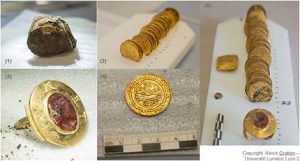Never before has such a large cache of silver deniers been discovered: Researchers
In mid-September, a large treasure—2,200 silver deniers and oboles; 21 Islamic gold dinars; a signet ring; and other objects made of gold—was unearthed during a dig at the Abbey of Cluny in the French department of Saône-et-Loire.
According to the French researchers, it’s the largest cache of silver deniers ever discovered. Furthermore, it’s the first time gold coins from Arab lands, silver deniers and a signet ring have been found hoarded together within a single, enclosed complex.
Anne Baud, an academic at the Université Lumière Lyon 2, and Anne Flammin, an engineer with the France-based National Centre for Scientific Research, led the archaeological investigation alongside a team of nine students from the university as well as researchers from the Maison de l’Orient et de la Méditerranée Jean Pouilloux.
The excavation campaign, authorized by the Bourgogne-Franche-Comté Regional Department of Cultural Affairs (DRAC), began in mid-September and ended in late October. It was part of a vast research program focused on the Abbey of Cluny.
Students in the Master of Archaeology and Archaeological Science program at the Université Lumière Lyon 2 have been participating in archaeological digs at the Abbey of Cluny since 2015. This experience in the field complements their academic training and offers insight into professional archaeology.
At the site, the team discovered a treasure consisting of:
- more than 2,200 silver deniers and oboles—mostly minted by the Abbey of Cluny and probably dating to the first half of the 12th century—in a cloth bag, traces of which remain on some of the coins; and
- a tanned hide bundle enclosing 21 Islamic gold dinars struck between 1121 and 1131 in Spain and Morocco, under the reign of Ali ibn Yusuf, who belonged to the Berber Almoravid dynasty; a gold signet ring with a red intaglio depicting the bust of a god and an inscription possibly dating the ring back to the first half of the 12th century; a folded sheet of gold foil weighing 24 grams and stored in a case; and a small circular object made of gold.

(1) Knotted tanned hide bundle before extraction of contents; (2, 4) gold dinars; (3) signet ring with intaglio; (5) contents of knotted tanned hide bundle. (Photo by Alexis Grattier)
A PRECIOUS FIND
“This is an exceptional find for a monastic setting and especially that of Cluny, which was one of the largest abbeys of Western Europe during the Middle Ages,” explains a statement issued by the National Centre for Scientific Research. “The treasure was buried in fill where it seems to have stayed for 850 years.”
“It includes items of remarkable value: 21 gold dinars and a signet ring, a very expensive piece of jewelry that few could own during the Middle Ages. At that time, Western currency was mostly dominated by the silver denier. Gold coins were reserved for rare transactions. The 2,200 or so silver deniers, struck at Cluny or nearby, would have been for everyday purchases. This is the largest stash of such coins ever found.”
“The fact that Arab currency, silver deniers, and a signet ring were enclosed together makes this discovery all the more interesting.”

